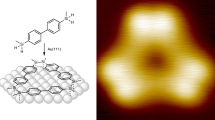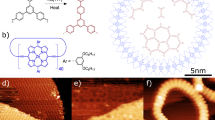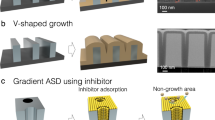Abstract
Using wet-chemical self-assembly, we demonstrate that standard surface reactions can be markedly altered. Although HF etching of Si surfaces is known to produce H-terminated surfaces, we show that up to ∼30% of a monolayer of stable Si–F bonds can be formed on atomically smooth Si(111) surfaces on HF reaction, when chemically isolated Si atoms are the target of the reaction. Similarly, ∼30% Si–OH termination can be achieved by immersion of the partially covered F–Si(111) surface in water without oxidation of the underlying Si substrate. Such reactions are possible when H-terminated (111)-oriented Si surfaces are initially uniformly patterned with methoxy groups. These findings are contrary to the knowledge built over the past twenty years and highlight the importance of steric interactions at surfaces and the possibility to stabilize products at surfaces that cannot be obtained on chemically homogeneous surfaces.
This is a preview of subscription content, access via your institution
Access options
Subscribe to this journal
Receive 12 print issues and online access
$259.00 per year
only $21.58 per issue
Buy this article
- Purchase on Springer Link
- Instant access to full article PDF
Prices may be subject to local taxes which are calculated during checkout






Similar content being viewed by others
References
Nicollian, E. H. & Goetzberger, A. Si–SiO2 interface—electrical properties as determined by the metal–insulator–silicon conductance technique. Bell Syst. Tech. J. 46, 1055–1133 (1967).
Green, M. A. Effects of pinholes, oxide traps, and surface-states on MIS solar cells. Appl. Phys. Lett. 33, 178–180 (1978).
Eades, W. D. & Swanson, R. M. Calculation of surface generation and recombination velocities at the Si–SiO2 interface. J. Appl. Phys. 58, 4267–4276 (1985).
Yablonovitch, E., Swanson, R. M., Eades, W. D. & Weinberger, B. R. Electron–hole recombination at the Si–SiO2 interface. Appl. Phys. Lett. 48, 245–247 (1986).
Sze, S. M. Physics of Semiconductor Devices (Wiley, 1981).
Yablonovitch, E., Allara, D. L., Chang, C. C., Gmitter, T. & Bright, T. B. Unusually low surface-recombination velocity on silicon and germanium surfaces. Phys. Rev. Lett. 57, 249–252 (1986).
Janshoff, A. et al. Macroporous p-type silicon Fabry–Perot layers. Fabrication, characterization, and applications in biosensing. J. Am. Chem. Soc. 120, 12108–12116 (1998).
Waggoner, P. S. & Craighead, H. G. Micro- and nanomechanical sensors for environmental, chemical, and biological detection. Lab Chip 7, 1238–1255 (2007).
Hines, M. A. In search of perfection: Understanding the highly defect-selective chemistry of anisotropic etching. Annu. Rev. Phys. Chem. 54, 29–56 (2003).
Lewis, N. S. & Nocera, D. G. Powering the planet: Chemical challenges in solar energy utilization. Proc. Natl Acad. Sci. USA 103, 15729–15735 (2006).
Dhayal, M., So, C., Choi, J. S. & Jun, J. Control of bio-MEMS surface chemical properties in micro fluidic devices for biological applications. J. Nanosci. Nanotech. 6, 3494–3498 (2006).
Chazalviel, J. N. Surface methoxylation as the key factor for the good performance of n-Si/methanol photoelectrochemical cells. J. Electroanal. Chem. 233, 37–48 (1987).
Buriak, J. M. Organometallic chemistry on silicon surfaces: Formation of functional monolayers bound through Si–C bonds. Chem. Commun. 1051–1060 (1999).
Wayner, D. D. M. & Wolkow, R. A. Organic modification of hydrogen terminated silicon surfaces. J. Chem. Soc. 2, 23–34 (2002).
Tan, M. X. et al. Progress in Inorganic Chemistry Vol. 41, 21–144 (Wiley, 1994).
Maiolo, J. R. et al. High aspect ratio silicon wire array photoelectrochemical cells. J. Am. Chem. Soc. 129, 12346–12347 (2007).
Maboudian, R. & Carraro, C. Surface chemistry and tribology of MEMS. Annu. Rev. Phys. Chem. 55, 35–54 (2004).
Kolasinski, K. W. The mechanism of Si etching in fluoride solutions. Phys. Chem. Chem. Phys. 5, 1270–1278 (2003).
Higashi, G. S., Becker, R. S., Chabal, Y. J. & Becker, A. J. Comparison of Si(111) surfaces prepared using aqueous-solutions of NH4F versus HF. Appl. Phys. Lett. 58, 1656–1658 (1991).
Dumas, P., Chabal, Y. J. & Jakob, P. Morphology of hydrogen-terminated Si(111) and Si(100) surfaces upon etching in HF and buffered-HF solutions. Surf. Sci. 270, 867–878 (1992).
Allongue, P., Kieling, V. & Gerischer, H. Etching mechanism and atomic-structure of H–Si(111) surfaces prepared in NH4F. Electrochim. Acta 40, 1353–1360 (1995).
Michalak, D. J., Gstrein, F. & Lewis, N. S. Interfacial energetics of silicon in contact with 11 M NH4F(aq), buffered HF(aq), 27 m HF(aq), and 18 M H2SO4 . J. Phys. Chem. C 111, 16516–16532 (2007).
Michalak, D. J., Gstrein, F. & Lewis, N. S. The role of band bending in affecting the surface recombination velocities for Si(111) in contact with aqueous acidic electrolytes. J. Phys. Chem. C 112, 5911–5921 (2008).
Luo, H. H. & Chidsey, C. E. D. D-Si(111)(1×1) surface for the study of silicon etching in aqueous solutions. Appl. Phys. Lett. 72, 477–479 (1998).
Ricca, A. & Bauschlicher, C. W. Accurate D0 values for SiF and SiF+. Chem. Phys. Lett. 287, 239–242 (1998).
Ubara, H., Imura, T. & Hiraki, A. Formation of Si–H bonds on the surface of microcrystalline silicon covered with SiOx by HF treatment. Solid State Commun. 50, 673–673 (1984).
Trucks, G. W., Raghavachari, K., Higashi, G. S. & Chabal, Y. J. Mechanism of HF etching of silicon surfaces: A theoretical understanding of hydrogen passivation. Phys. Rev. Lett. 65, 504–507 (1990).
Zhang, R. Q., Zhao, Y. L. & Teo, B. K. Fluorination-induced back-bond weakening and hydrogen passivation on HF-etched Si surfaces. Phys. Rev. B 69, 1253191–1253198 (2004).
Higashi, G. S., Chabal, Y. J., Trucks, G. W. & Raghavachari, K. Ideal hydrogen termination of the Si-(111) surface. Appl. Phys. Lett. 56, 656–658 (1990).
Chabal, Y. J., Higashi, G. S. & Small, R. J. in Handbook of Silicon Wafer Cleaning Technology (eds Reinhardt, K. A. & Kern, W.) (William Andrew, 2007).
Chabal, Y. J. & Christman, S. B. Evidence of dissociation of water on the Si(100)2×1 Surface. Phys. Rev. B 29, 6974–6976 (1984).
Chabal, Y. J. Hydride formation on the Si(100):H2O surface. Phys. Rev. B 29, 3677–3680 (1984).
Michalak, D. J., Amy, S. R., Esteve, A. & Chabal, Y. J. Investigation of the chemical purity of silicon surfaces reacted with liquid methanol. J. Phys. Chem. C 112, 11907–11919 (2008).
Bateman, J. E., Eagling, R. D., Horrocks, B. R. & Houlton, A. A deuterium labeling, FTIR, and ab initio investigation of the solution-phase thermal reactions of alcohols and alkenes with hydrogen-terminated silicon surfaces. J. Phys. Chem. B 104, 5557–5565 (2000).
Warntjes, M., Vieillard, C., Ozanam, F. & Chazalviel, J. N. Electrochemical methoxylation of porous silicon surface. J. Electrochem. Soc. 142, 4138–4142 (1995).
Michalak, D. J., Rivillon, S., Chabal, Y. J., Esteve, A. & Lewis, N. S. Infrared spectroscopic investigation of the reaction of hydrogen-terminated, (111)-oriented, silicon surfaces with liquid methanol. J. Phys. Chem. B 110, 20426–20434 (2006).
Solares, S. D., Michalak, D. J., Goddard, W. A. & Lewis, N. S. Theoretical investigation of the structure and coverage of the Si(111)–OCH3 surface. J. Phys. Chem. B 110, 8171–8175 (2006).
Ferguson, G. A., Rivillon, S., Chabal, Y. J. & Raghavachari, K. The structure and vibrational spectrum of the Si(111)–H/Cl surface. J. Phys. Chem. C (in the press).
Watanabe, S. & Shigeno, M. Fluorine adsorption and etching on Si(111):SiH surface during immersion in HF solution. Japan. J. Appl. Phys. 31, 1702–1708 (1992).
Struck, L. M. et al. Vibrational study of silicon oxidation: H2O on Si(100). Surf. Sci. 380, 444–454 (1996).
Graf, D., Grundner, M. & Schulz, R. Reaction of water with hydrofluoric acid treated silicon(111) and (100) surfaces. J. Vac. Sci. Technol. A 7, 808–813 (1989).
Burrows, V. A. & Yota, J. A surface IR study of inorganic film formation GaAs, silicon and germanium by aqueous NH4F, and HF. Thin Solid Films 193–194, 371–381 (1990).
Chabal, Y. J. Infrared Study of the chemisorption of hydrogen and water on vicinal Si(100)-2×1 surfaces. J. Vac. Sci. Technol. A 3, 1448–1451 (1985).
Ho, M.-T. et al. In situ infrared spectroscopy of hafnium oxide growth on hydrogen-terminated silicon surfaces by atomic layer deposition. Appl. Phys. Lett. 87, 133103 (2005).
Chabal, Y. J. Surface infrared-spectroscopy. Surf. Sci. Rep. 8, 211–357 (1988).
Aureau, D., Rappich, J., Allongue, P., Ozanam, F. & Chazalviel, J. N. In-situ monitoring of the electronic properties and the pH stability of grafted Si(111) using photoluminescene, surface photovoltage, interface capacitance and FTIR measurements. J. Electroanal. Chem. (in the press).
Acknowledgements
We acknowledge the support of the National Science Foundation, through grant CHE-0415652 at Rutgers and UT Dallas, and through the US-France cooperative research programme (NSF-INT-0341053) for facilitating the international collaboration with the LAAS at Toulouse, and associated CALMIP computer resources. We are also grateful for a long-time collaboration and stimulating discussions with N. Lewis at Caltech, to B. Yakshinskiy and the late T. Madey at Rutgers for help with the XPS experiments, and to A. Malko and E. Danilov at UT Dallas for help with photoluminescence experiments. We also acknowledge J.-F. Veyan at UT Dallas, and J. Ballard and J. Randall at Zyvex Labs for preliminary low-energy electron diffraction and scanning tunnelling microscopy data.
Author information
Authors and Affiliations
Contributions
D.J.M. conceived and realized the bulk of the experiments, collaborating actively with S.R.A. M.D. carried out the initial ALD experiments. S.R.A. carried out studies of DMCS reaction. D.A. completed many of the infrared and XPS experiments and carried out all contact angle and photoluminescence experiments. A.E. carried out the theoretical work. Y.J.C. supervised and sustained this work during its development and fruition over the past five years.
Corresponding author
Ethics declarations
Competing interests
The authors declare no competing financial interests.
Supplementary information
Supplementary Information
Supplementary Information (PDF 647 kb)
Rights and permissions
About this article
Cite this article
Michalak, D., Amy, S., Aureau, D. et al. Nanopatterning Si(111) surfaces as a selective surface-chemistry route. Nature Mater 9, 266–271 (2010). https://doi.org/10.1038/nmat2611
Received:
Accepted:
Published:
Issue Date:
DOI: https://doi.org/10.1038/nmat2611
This article is cited by
-
Pd Nanoparticles on SBA-15 Containing F for 2-Ethyl-Anthraquinone Hydrogenation: Effects of Hydrophobicity
Catalysis Letters (2022)
-
Selective Atomic-Level Etching on Short S-Glass Fibres to Control Interfacial Properties for Restorative Dental Composites
Scientific Reports (2019)
-
Curved surface effect and manipulation of electronic states in nanosilicon
Scientific Reports (2017)
-
Friction and Tribochemical Wear Behaviors of Native Oxide Layer on Silicon at Nanoscale
Tribology Letters (2017)
-
Heterogeneous reduction of carbon dioxide by hydride-terminated silicon nanocrystals
Nature Communications (2016)



